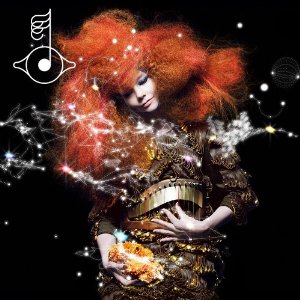Dancing about architecture is tricky enough as it is without tasking yourself to review a record that’s all about escaping from the tyranny of established forms. But we’ve a round hole here in desperate need of a square peg, so have at you, Gudmundsdottir. Biophilia was conceived both as an alternative to Bjork’s experience of classical musical education and as riposte to doommongers who moan about the internet killing music. It was also inspired by her experiences both of the Icelandic bank crash, industrial exploitation of her homeland, and a throat infection that forced her to change her whole way of life. It’s all about abandoning old, failing models and starting anew with ingenuity and fun. It’s anti-abstraction. It doesn’t want you to explain it, it wants you to get your fingers mucky and get involved.
So, if you haven’t already heard, we’ll try and make this bit quick: Biophilia comprises not just 10 songs, but 10 accompanying iPad/iPod apps, as well as a live show and musical educational workshops that will tour eight cities across the world over the next three years. Each of the apps includes an animation, an animated score, lyrics, an academic essay by musicologist Nicola Dibben and an instrument-style game that allows you to deconstruct and play with aspects of the song. Each song and app relates to both an aspect of nature, like crystals or lunar cycles, and a building block of music, like scales or rhythm.
Phew. Do you really need to know any of this to listen to Biophilia? No – Bjork’s quite adamant that the visual and interactive aspects are strictly optional, and the album can stand on its own musical merits. Having played with all the apps and seen the live shows, we can assure you that they are really, really very amazing. But say you don’t feel like forking out 400-odd quid on an iPad and another £13.41 on all the apps, plus flights to Reyjavik or New York to catch the next residency, the good news is that everything you need is in just Biophilia the album. That’s not that say, the eerie beauty of ‘Moon”s delicate, silvery harp prancing isn’t enhanced by its sequencer app, a series of white beads arranged around a female pelvic bone, through which water controlled by a full moon flows to hit notes of your choice… just that all the beauty is already there. All you need is the ideas.
The emotional and lyrical themes of each song neatly fit into their parent concepts; the idea of hormonal crisis and emotional rebirth here "as if the healthiest pastime is being in life-threatening circumstances / And once again being reborn" fits neatly with the cyclical repetition of lunar cycles or a sequencer. ‘Thunderbolt’ which muses on arpeggios, seeks the spark of life in a bolt of lightning, Bjork plotting and pleading "have I too often craved miracles?" over soft, ominous organ, then hit by inspiration in the form of a thrumming, jagged Tesla Coil, and the benediction of her close-harmonied Icelandic choirgirls as her formidable voice shoots for the stars and "universal intimacy". An amazing, single-take vocal swoop from the choir also opens ‘Cosmogony’, a hymn to universal equilibrium. Over the wombiest of heart-beats, interstellar sub-bass pooms and starclouds of choral slides, the Big Bang becomes just one creation myth nestled among Chinese and Native American versions, as Bjork sits at the centre of her universe, cooing "heaven, heaven’s bodies, whirl around me, make me wonder" like Brian Cox with much better tunes.
As well as these moments of delicate, pure beauty that fulfil her promise of a "modern music of the spheres", Biophilia also features some of Bjork’s tastiest beatalanches in some time: ‘Crystalline’ sports a furious Amen-breaked hissy fit from UK bass producers 16-bit, while the fantastic ‘Mutual Core”s pipe organ chords are a brooding storm that can only end one way. The neat image of the battle of continental plates as lovers struggling to reach an agreement builds rumbling and grating beats until the tension can hold no longer, the choir swoop in like Furies through the cracks and rends, and Bjork finds release through rage in a flagrantly sexy chorus. "this eruption… undoes stagnation / You didn’t know I had it in me".
As befits the album’s semi-educational intent, some of the ideas and structures here are incredibly complicated – for example the bizarre, shifting rhythms of ‘DNA’ or the beguilingly irregular patterns of the gravity-driven pendulum harp on ‘Solstice’. However, throughout Biophilia is simple and pure; the twinkles of the gameleste sounds and the stuttering beats will be familiar and comfortable to longtime Bjorkheads. Nothing here is complex or highbrow, but instead filled with the joy and clarity of understanding and connecting. One of the album’s most beautiful moments is ‘Virus’, in which the hang, a turtle-shaped steel drum, represents the healthy host body, the gameleste a passive-aggressive virus whose multiplying arrangement slowly takes over the song. Bjork’s own experience of candida in her throat informs the love/hate relationship: "I knock on your skin and I am in… my sweet adversary". As Bjork puts it on ‘Thunderbolt’, "my romantic gene is dominant" and nearly all of these songs come across as much as love songs or friendship songs every bit as much as they do ‘science songs’. The solutions that Biophilia presents to the problems of failed politics, music industry or education are, in the end, her constant emotional failsafes: courage, love, and openness. And you don’t need an app for that.


